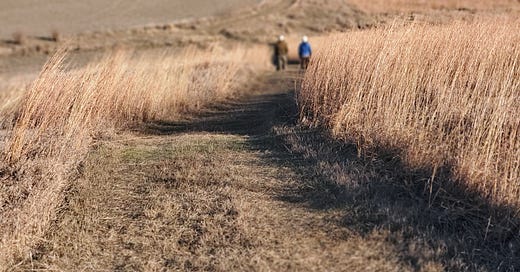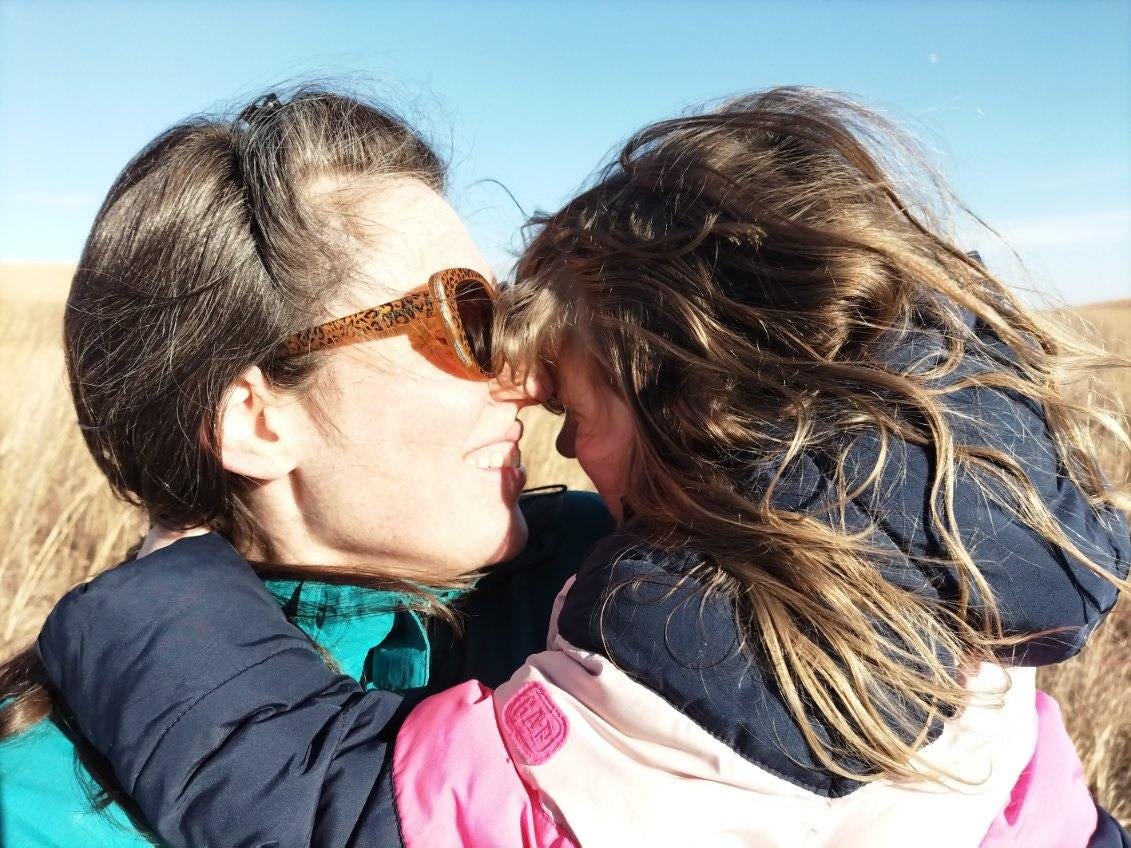Like many a four-year-old, my daughter is both an incessant storyteller and story-receiver. She wants to read the same book over and over again, or watch the same movie over and over, and then have us repeat those same stories to her (over and over) in our own words. When we play games, we often replay and rework the same short scenes that she creates and directs. It feels as though she wants to be sure that she fully understands, or fully embodies, a particular story.
“Tell me again,” she’ll say, and I can feel her focus, how she is processing in real time, catching new details, or new layers of meaning, wanting to keep the story alive and present.
She also narrates her life from her 4-year-old perspective, and it’s a delight to hear what constitutes a major plot point. (We went out to breakfast the other day and she looked up at me after receiving her bagel and said, “It’s unbelievable how much cream cheese I got from this lady.”)
I have to work to remember that while we’re often doing the same activity or sharing an experience, the stories we might relate afterwards are often completely different. It makes me extra grateful that she is a willing and enthusiastic narrator of her experience.
We went to Nebraska in early December to visit my dad, stepmom, grandmother, and extended family and friends. While we were there, my dad asked if he could take Aspen to see a prairie. Glacier Creek Preserve, just northwest of Omaha, is a restored tallgrass prairie, part of which my dad first visited around fifty years ago as an ecology student at the University of Nebraska. Now, as a retired botanist, he visits frequently as a volunteer who helps with their prescribed fire program.
This—restoring grasslands—is one of the central narrative threads of my father’s life. Prairies not only serve as some of his major plot points, but they also make up a large part of his understanding of himself and his place in the world.
His love of prairies is something he passed on to me: in the specific sense of what has become my own growing interest in learning more about this landscape, and in the broader sense of passing on the possibility—or necessity—of caring for place. So, I was touched that he wanted to share the prairie with his granddaughter, bringing that braided story into a new generation.
I was also curious how she would receive that story, braid it into her own understanding.
Approximately 98% of Nebraska’s tallgrass prairies were lost to the plow and development between the 1860s and today. This prairie at Glacier Creek was cropland not so long ago. It thus does not have 1,000-plus year old topsoil or an unbroken legacy of biological diversity. It is barely an infant in prairie terms, a mere half century old.
One of the many things I love about considering the stories of landscapes is that they are so very long and mysterious. Their time stretches and turns and layers far beyond our own time—behind, ahead, above, below—and far beyond much our understanding. But this doesn’t mean we can’t have real and meaningful relationships with landscapes in the present moment, and even through generations, when our time and the land’s time intersect and interact.
This, too—the touching down of our stories upon the wide story of the land, or, perhaps better stated: the wide story of the land folding us briefly into its long life—is an opportunity for, an opening into, love.
If I were to trace the narrative arc of six generations of my family in Nebraska, it would tell a story of deep relationship to the land, but not an untroubled one. It’s a story of the plow and of displacement, of successful and failed projects of control, and finally of restoration and healing, of seeking to make amends.
As we walked the trails at Glacier Creek, evidence of similar stories were everywhere to be seen on the landscape, in ways I could read, and in ways only my father and uncles (also prairie ecologists) could read, and certainly in ways none of us could read. There were square patches of recent burns where native grassland species will grow more vibrantly in the spring, there was a stark delineation between restored prairie and cropland. There was a weathered graveyard where an early pioneering farming family is buried, many of whom died very young. There was a trim line of modern homes, running along one of the surrounding hilltops.
And there were three generations of one family, walking together in the cold wind and bright sun, each of us holding this particular, brief intersection of ourselves with this landscape.
The land, too, is a storyteller and story receiver. The prairie and its layered stories has shown up in our family, over and over.
“Tell me again,” I find myself saying, and I can feel my own focus, how I am processing in real time, catching new details, or new layers of meaning, wanting to keep the story alive and present. How I want to be sure that I fully understand.
For Aspen’s part, she pulled on a dried, golden blade of tall grass until the top few inches popped off in her hand and became a magic wand. Waving it, she took off running, the prairie grasses swaying above her head on either side of her path.
Mother, Creature, Kin available for pre-order!
You can now pre-order my forthcoming book, MOTHER, CREATURE, KIN: What We Learn from Nature’s Mothers in a Time of Unraveling.
“In prose that teems with longing, lyricism, and knowledge of ecology, Steinauer-Scudder writes of the silent flight and aural maps of barn owls, of nursing whales, of real and imagined forests, of tidal marshes, of ancient single-celled organisms, and of newly planted gardens. The creatures inhabiting these stories teach us about centering, belonging, entanglement, edgework, homemaking, and how to imagine the future. Rooted in wonder while never shying away from loss, Mother, Creature, Kin reaches toward a language of inclusive care learned from creatures living at the brink.”
Writing workshops for the New Year:
(Re)Connecting to Creative Practice: Finding ritual and rhythm in the midst of uncertainty
With everything going on in the world, it can be a challenge to maintain both the joy and the discipline of creative practice, and to remember and re-inhabit it as worthy and valuable. Over three sessions, we’ll explore together ways of reconnecting to our writing as a creative and nourishing practice, weaving together elements of ritual and community.
For the duration of the three-week course, participants will have the option to write together every morning over Zoom. These writing sessions will entail a brief check-in followed by time to write in silence and community.
Dates: January 9th, 16th, 23rd from 7:30-8:30pm EST (plus: optional morning writing sessions from 8:00-9:00am, weekdays from January 9th-23rd)
Cost: Sliding scale, $25-$75
Register HERE.
Writing Creatures:
Is there an animal or plant you’ve been longing to write about? Are you looking for ways to bring more wildness into your writing? Over three sessions, we’ll delve into the world of a creature we’re interested in learning more about, stretch our writing practice across the species divide, and consider how writing can be a space to build bridges of empathy and care with the living world.
Dates & Time: February 6th, 13th, & 20th, from 8:00-9:00pm EST
Cost: Sliding scale, $25-$75
Register HERE.






This past summer, I travelled to Kansas and visited the prairies where my great grandparents homesteaded, and my grandmother and mother grew up. A favorite photo of my mother is when she was six years old holding a bouquet of flowers as she sat in the middle of a prairie. This essay touched me deeply. Thanks so much!
Chelsea, thank you so much for this walk on the prairie, so loved it.
And I very much agree when you say "The land, too, is a storyteller and story receiver. The prairie and its layered stories has shown up in our family, over and over". Just the land in my garden moves and changes, the hill is slowly moving my house with it. It's a constant changing story like the trees, the stream, me, everything all around.
I wish you a very happy and harmonious new year.